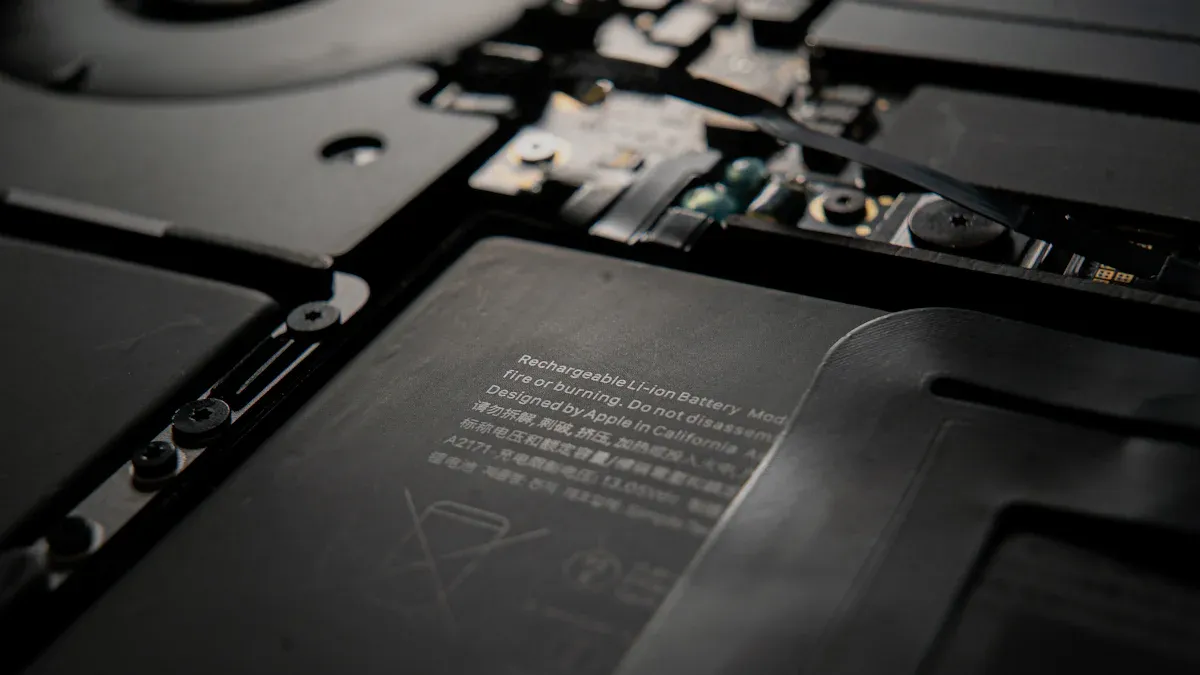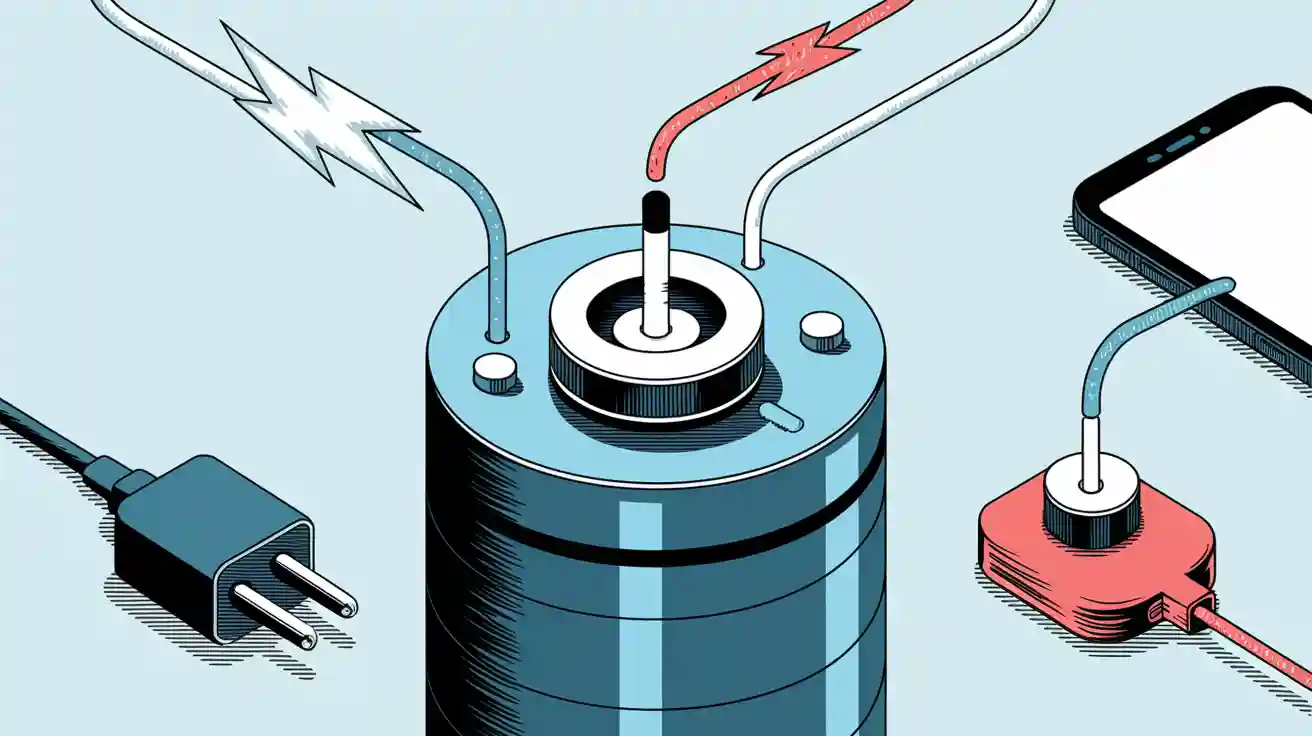How does a Recharge Lithium Battery Charges and Discharges?
A recharge lithium battery stores and releases energy through a simple yet powerful process. You rely on this rechargeable battery every day in devices like smartphones, electric vehicles, and medical equipment. During charging, lithium ions move between the anode and cathode inside the lithium-ion battery, crossing through the electrolyte. This movement allows the battery to be charged and discharged efficiently. Understanding how ions flow and interact with each component helps you appreciate the charge and discharge process that powers your devices.
- Consumer electronics
- Transportation
- Wearable technology
- Medical equipment
- Energy storage systems
Key Takeaways
- Lithium-ion batteries charge and discharge by moving lithium ions between the anode and cathode, enabling efficient energy storage.
- The charging process consists of two stages: constant current (CC) for fast charging and constant voltage (CV) for safe, full charging.
- Understanding the components, like the electrolyte and separator, helps you appreciate how batteries operate safely and effectively.
- Monitor the depth of discharge to extend battery life; avoid extreme temperatures and high discharge rates for optimal performance.
- Use the recommended charger for your device to prevent overcharging and ensure the longevity of your lithium battery.
Recharge Lithium Battery Components

A rechargeable lithium battery relies on several key components that work together to store and deliver energy. Each part plays a unique role in the charging and discharging process. Understanding these components helps you see why lithium batteries power so many of your devices efficiently and safely.
Anode and Cathode
The anode and cathode serve as the main sites for lithium ion movement during charging and discharging. The anode usually consists of carbon-based materials, such as graphite, which store lithium ions when you charge the battery. During discharge, the anode releases these ions, allowing energy to flow to your device. The cathode, often made from compounds like NMC (Nickel Manganese Cobalt) or NCA (Nickel Cobalt Aluminum), accepts lithium ions during discharge and releases them during charging.
The choice of materials for the anode and cathode directly affects how much energy the battery can store, how fast it charges, and how long it lasts. For example, the microstructure and texture of the anode influence charge and discharge rates, while the cathode material determines energy density and safety.
Here is a table summarizing the roles of each component:
| Component | Role in Charging/Discharging |
|---|---|
| Cathode | Accepts lithium ions during discharge and releases them during charging. |
| Anode | Stores lithium ions during charging and releases them during discharging. |
| Electrolyte | Facilitates the movement of lithium ions between anode and cathode while blocking electrons. |
| Separator | Prevents direct contact between anode and cathode to avoid short circuits. |
| Binder | Holds the battery components together. |
| Current collectors | Ensure electrons travel to the external circuit. |
Electrolyte and Separator
The electrolyte acts as a pathway for lithium ions to move between the anode and cathode. It allows ions to flow freely but blocks electrons, which must travel through the external circuit to power your device. The separator sits between the anode and cathode. Its main job is to prevent them from touching, which would cause a short circuit, while still letting ions pass through.
- Electrolyte: Enables lithium ion movement but blocks electrons.
- Separator: Keeps the anode and cathode apart, ensuring safe operation.
These components work together to make sure your battery delivers energy safely and efficiently every time you use your device.
Lithium-Ion Battery Charging
Charging a lithium-ion battery involves a precise process that keeps your devices running safely and efficiently. You can break down this process into two main stages: constant current (CC) and constant voltage (CV). Understanding these charging methods helps you maximize the performance and lifespan of your recharge lithium battery.
CC and CV Charging Stages
You start the charging process with the constant current (CC) stage. In this stage, the charger supplies a steady current to the battery. The voltage gradually rises as the battery stores more energy. This method quickly brings the battery to about 70-80% of its full capacity. Once the voltage reaches a set limit, the charger switches to the constant voltage (CV) stage.
During the CV stage, the charger holds the voltage steady while the current gradually decreases. This stage ensures the battery reaches full capacity without overcharging. The CV stage protects the battery’s health and extends its lifespan.
Here is a table comparing the two charging stages:
| Charging Mode | Advantages | Disadvantages |
|---|---|---|
| Constant Current (CC) | - Fast Charging: Quickly charges the battery to a significant capacity. | - Overcharging Risk: Can lead to battery degradation and safety hazards if not controlled. |
| - Uniform Charging: Ensures even charge distribution across battery cells. | ||
| Constant Voltage (CV) | - Safe Charging: Prevents overcharging and enhances battery longevity. | - Slow Charging: Takes longer to fully charge the battery compared to CC mode. |
| - Full Charging: Allows the battery to reach maximum capacity safely. |
You will find that most lithium-ion battery chargers use both stages to balance speed and safety. The voltage limit depends on the battery type. For example, a typical lithium-ion battery charges up to 4.2 to 4.3 volts per cell. The table below shows the maximum charge voltage for different lithium battery types:
| Type of Lithium Battery | Max Charge Voltage (Volts per Cell) |
|---|---|
| Li-ion Batteries | 4.2 to 4.3 |
| LiPo Batteries | 4.2 to 4.3 |
| LiFePO4 Batteries | 3.6 to 3.8 |
Ion Movement in Charging
When you charge a lithium-ion battery, lithium ions move from the cathode to the anode. This movement happens because the charger creates a potential difference, similar to water pressure pushing fluid through a pipe. The external electrical current drives the ions through the electrolyte and across the separator.
- Lithium ions leave the cathode and travel through the electrolyte.
- The ions pass through the separator, which keeps the anode and cathode apart.
- The ions reach the anode and get stored there until you use the battery.
This charging process stores energy in the battery, ready for you to use when you need it. The movement of ions is the core of how a recharge lithium battery works. You can think of this process as a two-way street: ions move one way during charging and the opposite way during discharge. This efficient charge and discharge cycle makes lithium-ion batteries ideal for many applications.
Fully Charged Indicators
You need to know when your battery is fully charged to avoid overcharging and extend its life. Several indicators help you determine when the charging process is complete:
| Method | Description |
|---|---|
| Voltage Measurement | Measure the voltage with a multimeter; full charge voltage is typically between 4.1V and 4.2V. |
| Charger Indicators | Look for LED indicators or digital displays on chargers that signal when charging is complete. |
| Battery Management Systems | Use BMS to monitor state of charge and receive alerts when fully charged. |
| Current Drop Method | Monitor the current during charging; a drop to near zero at around 14.6V indicates full charge. |
Most modern chargers and devices use a combination of these methods. When the battery reaches its maximum voltage and the current drops to a low level, the charger stops supplying power. Some chargers provide a topping charge, which keeps the battery at full capacity without overcharging. This careful control ensures your recharge lithium battery remains safe and reliable through many charge and discharge cycles.
Tip: Always use the recommended charger for your device. Proper charging methods protect your battery and help it last longer.
Charge and Discharge Process

Understanding the charge and discharge process in a recharge lithium battery helps you manage your devices more effectively. This process determines how energy moves within the battery and how you can maximize its performance and lifespan. Let’s break down what happens during each stage and how you can calculate the time your battery will last.
Ion Movement in Discharge
When you use your device, the recharge lithium battery begins the discharging process. Lithium ions move from the anode to the cathode through the electrolyte. This movement is the reverse of what happens during charging. As the ions travel, they generate an electric current that powers your device.
- Lithium ions leave the anode and pass through the electrolyte.
- The ions reach the cathode, where they intercalate into the cathode material.
- Electrons flow through the external circuit, providing energy to your device.
You can see the chemical reactions at each electrode during discharge:
- The anode undergoes oxidation:
- LiₓC₆ → xC₆ + xLi⁺ + xe⁻
- The cathode undergoes reduction:
- Li₁₋ₓCoO₂ + xLi⁺ + xe⁻ → LiCoO₂
This process is essential for the battery to deliver power. The depth of discharge, which measures how much energy you have used compared to the battery’s total capacity, plays a critical role in battery health. If you frequently use a high depth of discharge, you may reduce the battery’s lifespan.
Note: The chemical reactions during discharge are the reverse of those during charging. This reversible process allows the battery to be charged and discharged many times.
Energy Release
As lithium ions move from the anode to the cathode, they create a flow of electrons in the external circuit. This flow releases electrical energy, which your device uses to operate. The rate at which energy is released depends on several factors:
- The consistency of the battery cells. Poor consistency can cause overcharge or over-discharge, which affects performance and safety.
- Temperature. Extreme temperatures can slow down lithium ion movement and reduce the battery’s discharge capacity.
- The discharge rate. If you use a high discharge rate, you may see reduced capacity due to polarization and heat buildup.
You should monitor the depth of discharge to avoid over-discharging the battery. Keeping the depth of discharge within recommended limits helps maintain battery performance and extends its cycle life.
⚡ Tip: Avoid exposing your battery to extreme temperatures and high discharge rates. This practice helps preserve capacity and ensures safe operation.
Discharge Time Formula
You can estimate how long your recharge lithium battery will last during use by applying a simple formula:
Run time (hours) = Battery Capacity (mAh) / Discharge Current (mA)
For example, if your battery has a capacity of 2000 mAh and your device draws 500 mA, the run time will be:
Run time = 2000 mAh / 500 mA = 4 hours
This formula works well for lithium-ion batteries at around a 1C discharge rate and room temperature (about 20°C). At lower discharge rates, the effective capacity may increase slightly, but the difference is usually less than 20%. The depth of discharge also affects the actual run time. If you use a higher depth of discharge, you may notice a decrease in battery performance over time.
Constant current (CC) discharging is a common method for testing and using batteries. In this method, the battery delivers a steady current throughout the discharge cycle. However, using only constant current protocols can underestimate battery lifetime by up to 38% compared to dynamic discharge protocols. Dynamic protocols, which vary the current, can help extend battery life and reduce capacity fade.
| Metric | Constant Current (CC) | Pulsed Current (PC) | Improvement (%) |
|---|---|---|---|
| Capacity Fade | Higher | Lower | 2 |
| Internal Resistance | Increased | Decreased | 8.7 |
You should consider both the depth of discharge and the discharge protocol when evaluating battery performance. Managing these factors allows you to get the most out of your recharge lithium battery and ensures it can be charged and discharged safely over many cycles.
Remember: Monitoring the depth of discharge and using appropriate discharge protocols can significantly improve battery longevity.
Lithium Battery Charging Characteristics
Efficiency and Self-Discharge Rate
You benefit from the high charging efficiency of a lithium-ion battery. This technology stands out because it loses less energy during the charging process compared to older battery types. You can see the difference in the table below:
| Battery Type | Average Voltage | Self-Discharge Rate | Memory Effect | Energy Density Comparison |
|---|---|---|---|---|
| Lithium-Ion | 3.6V | 2-5% (month) | None | 1.5x (volume), 2x (weight) |
| Nickel-Cadmium | 1.2V | 15-30% (month) | Yes | Lower |
| Nickel-Metal Hydride | 1.2V | 25-35% (month) | Yes | Lower |
A lithium-ion battery has a self-discharge rate of only 2-5% per month. Nickel-based batteries lose much more energy over the same period. You do not need to worry about the memory effect, which can reduce the usable depth of older batteries. The high energy density means you get more power in a smaller package, making lithium battery charging ideal for portable devices.
Cycle Life and Degradation
You want your battery to last as long as possible. The cycle life of a lithium-ion battery usually ranges from 300 to 1000 cycles before its capacity drops below 80%. Depth of discharge affects this number. If you use shallow depth cycles, you extend the battery’s life. Manufacturers test cycle life by monitoring charge and discharge in controlled environments. They track changes in capacity and depth during each cycle.
Degradation happens for several reasons:
- Calendar aging causes chemical changes over time.
- Fast charging can lead to lithium plating and increased resistance.
- High temperatures speed up electrolyte degradation.
- Overcharging and deep discharge cycles damage the battery.
Recent advancements, such as solid-state batteries and silicon anodes, improve charging efficiency and cycle life. You benefit from longer-lasting batteries and faster charging speeds.
Safety Features
You rely on safety features to protect your lithium-ion battery during charging and discharging. Modern batteries include fuse protection, real-time diagnostics, and a battery management system. These systems monitor temperature, voltage, and current, preventing overheating and short circuits. Protective circuit modules and secure housing reduce the risk of accidental contact and fire hazards.
Regulatory standards, such as IEC 62133 and UL 1642, require manufacturers to label and package batteries correctly. These rules help you handle batteries safely and avoid dangerous situations. Monitoring charge and discharge depth with a battery management system ensures safe operation and extends cycle life.
You now understand how a lithium battery charges and discharges by moving ions between the anode and cathode. This process gives you reliable power for your devices. Lithium-ion batteries stand out for their high energy density and long cycle life.
| Battery Type | Energy Density (Wh/kg) |
|---|---|
| Lithium-ion | 100-265 |
| Other Rechargeable | Lower than 100 |
Lithium-ion batteries retain their charge longer than other types, making them ideal for portable electronics.
When you choose a battery, consider its efficiency, safety, and environmental impact. If you have questions about rechargeable lithium batteries or want to discuss partnerships, feel free to reach out.
-

 May.2025.11.24Ternary Lithium Battery vs Lithium-ion: Complete Comparison Guide (2025 Edition)Learn More
May.2025.11.24Ternary Lithium Battery vs Lithium-ion: Complete Comparison Guide (2025 Edition)Learn More -

 May.2025.11.214S2P 18650 14.8V Battery: Complete Technical Guide, Specs, Applications & SafetyLearn More
May.2025.11.214S2P 18650 14.8V Battery: Complete Technical Guide, Specs, Applications & SafetyLearn More -

 May.2025.11.18PCM vs BMS in Lithium Batteries: What’s the Difference and Which One Do You Need?Learn More
May.2025.11.18PCM vs BMS in Lithium Batteries: What’s the Difference and Which One Do You Need?Learn More -

 May.2025.11.17Custom Li-ion Battery Design for Medical Devices (2025 Comprehensive Guide)Learn More
May.2025.11.17Custom Li-ion Battery Design for Medical Devices (2025 Comprehensive Guide)Learn More -

 May.2025.11.17The Future of Lithium-Ion Batteries: Innovation, Sustainability, and Global Market TrendsLearn More
May.2025.11.17The Future of Lithium-Ion Batteries: Innovation, Sustainability, and Global Market TrendsLearn More
















